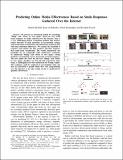Predicting Online Media Effectiveness Based on Smile Responses Gathered Over the Internet
Author(s)
McDuff, Daniel Jonathan; Demirdjian, David; Picard, Rosalind W.; El Kaliouby, Rana
DownloadPicard_Predicting online.pdf (2.696Mb)
OPEN_ACCESS_POLICY
Open Access Policy
Creative Commons Attribution-Noncommercial-Share Alike
Terms of use
Metadata
Show full item recordAbstract
We present an automated method for classifying “liking” and “desire to view again” based on over 1,500 facial responses to media collected over the Internet. This is a very challenging pattern recognition problem that involves robust detection of smile intensities in uncontrolled settings and classification of naturalistic and spontaneous temporal data with large individual differences. We examine the manifold of responses and analyze the false positives and false negatives that result from classification. The results demonstrate the possibility for an ecologically valid, unobtrusive, evaluation of commercial “liking” and “desire to view again”, strong predictors of marketing success, based only on facial responses. The area under the curve for the best “liking” and “desire to view again” classifiers was 0.8 and 0.78 respectively when using a challenging leave-one-commercial-out testing regime. The technique could be employed in personalizing video ads that are presented to people whilst they view programming over the Internet or in copy testing of ads to unobtrusively quantify effectiveness.
Date issued
2013-04Department
Massachusetts Institute of Technology. Computer Science and Artificial Intelligence Laboratory; Massachusetts Institute of Technology. Media Laboratory; Program in Media Arts and Sciences (Massachusetts Institute of Technology)Journal
Proceedings of the 10th IEEE International Conference and Workshops on Automatic Face and Gesture Recognition (FG 2013)
Publisher
Institute of Electrical and Electronics Engineers (IEEE)
Citation
McDuff, Daniel et al. “Predicting Online Media Effectiveness Based on Smile Responses Gathered over the Internet.” IEEE, 2013. 1–7.
Version: Author's final manuscript
ISBN
9781467355445
9781467355452